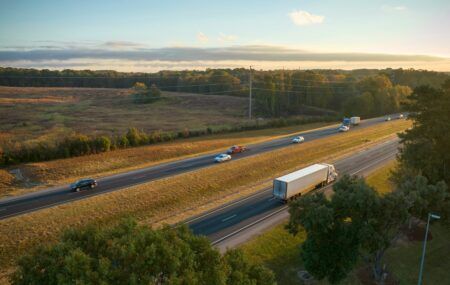Scientists at EarthSense Systems, a joint venture between aerial mapping company Bluesky and the University of Leicester, have completed a research project considering the economic effectiveness of different schemes to reduce urban air pollution, with trees revealed to be the most cost-effective solution.
In a study of one of Europe’s busiest shopping areas, Oxford Street in London, the project team compared the comparative performance of a range of options, including trees, solid barriers, and even a special paint that uses light to activate a chemical reaction to reduce the accumulation of pollution. The study will inform investment decisions for critical infrastructure in future cities, helping to protect residents against the damaging effects of harmful emissions.
EarthSense simulated airflows and pollution dispersion patterns, taking into account local weather conditions. Solid barriers, with or without an application of the innovative photocatalytic paint, were shown to improve air quality on pavements and roads, yet the use of the paint on building facades had little impact. Planting of trees also showed a reduction in pollutant levels for the particular geometry of Oxford Street and, at up to 100 times cheaper than other strategies, was concluded to be the most cost effective.
There are various types of mitigation strategies available to combat urban air pollution and they can be broadly defined under three categories:
Control of quantity, such as through congestion charging;
Control of emission intensity, for example use of a ‘carbon tax’;
Control of source-receptor pathways, such as through passive control measures that block the source or pathway of emissions.
The EarthSense Oxford Street study focused on strategies that used control of source-receptor pathways, and considered measures that improved the aerodynamic dispersion of emissions.
The EarthSense Systems joint venture aims to deliver products that enable authorities and governments to visualize and solve air quality issues. The JV enables policymakers, planners and those responsible for delivering results to access real-world information in order to support decision making. With a mix of hardware (air quality sensors), software (bespoke modeling), data (derived and complementary), and scientists, EarthSense is poised to take a lead in air quality monitoring systems and services, delivering high value information to a range of clients.
“Road traffic emissions are the largest contributors of air pollution in the urban environment, accounting for up to 40% of the total NO? emissions in Europe and contributing between 47-53% of all emissions in London. Studies have also directly linked outdoor air pollution with hospital admissions for various cardiovascular and respiratory conditions in our capital,” noted Dr Antoine Jeanjean, head of modeling at EarthSense Systems.
“Improving aerodynamic dispersion can be achieved by altering street geometry or introducing barriers. Green infrastructure or the application of specialist coatings can also be used to promote pollutant deposition and therefore reduce NO? concentrations. However, these mitigation strategies can only deliver minimum reductions in air pollution, so it is imperative that vehicle emissions are targeted at source if we are to improve urban air quality.”




